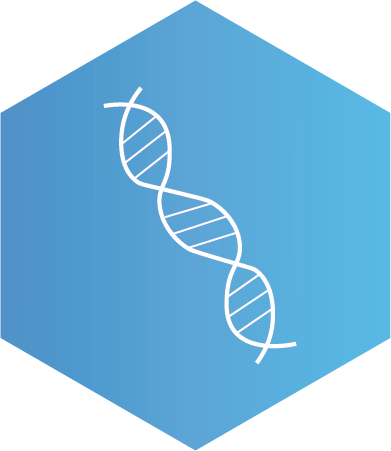NGS for Quality Control Testing of Biologics
One of the advantages of NGS testing is that it allows multiple analyses in the same biological product. Therefore, with just one data set it is possible to perform multiple analyses.
There are two main approaches to NGS – short-read sequencing, where DNA has to be fragmented into short ~200 bp long sequences for sequencing, and long-read sequencing, where there are no size limitations in read length. ViruSure has focused its efforts on the Oxford Nanopore’s long-read sequencing approach, as long reads bring the benefit of recovering more of a contaminant’s genome within a smaller data set and reduced signal to noise ratios, which decreases the risk of detecting false positive signals. Additionally, it allows to sequence through longer genome stretches (including e.g., repetitive regions) leading to improved resolutions in sequence identity testing approaches.

Adventitious Agents

Genetic Characterization
Adventitious Agents
Sterility and Mycoplasma
Sterility testing is performed to detect the presence of microbiological contaminations. Regulators encourage the pharmaceutical industry to develop faster, alternative methods for sterility tests (Deutschmann et al., 2023).
Adventitious Viruses
Current testing methods are in-vivo and in-vitro adventitious agent testing as well as qPCR testing. These methods provide a great combination of techniques to reduce the risk of viral contaminations in biopharmaceuticals, but these methods also have their limitations. NGS combines the advantages of both assays.
Investigation of possible contamination events in the production cycle of biologics
Since NGS does not need any prior sequence knowledge, it is an ideal tool for the rapid identification of a contaminant in potential contaminations events over the entire development and production process of a biopharmaceutical product.
Genetic Characterization
Sequencing
NGS is especially useful for large genetic inserts, to reduce the analysis time when compared to classical Sanger Sequencing.
Resequencing of genetic inserts
The stability of genetic inserts within cell banks of virus stocks has to be demonstrated over the entire production cycle.
NGS can be used to compare the sequence and location of the insert to a reference sequence and possible mutations can be detected.
mRNA sequencing
To confirm the correct transcription of a genetic insert into mRNA, cDNA can be generated and compared to a reference sequence after processing in an NGS run.
Sequence Identity confirmation for viral vectors
NGS can be used for the sequencing of viral vectors. Using a reference sequence, the identity of the viral vector can be confirmed.
The same data set can be applied for mutation screening to detect any possible mutations that have occurred, when comparing to the original reference sequence.
Biological Products Tested by NGS
NGS has universal use in the testing of biological products. At ViruSure, we can test, for example, the following biological products by NGS:
- Recombinant proteins (e.g. mAbs) are still dominating the biotech products on the market, especially in the sector of oncology. They are produced in cell line (bacterial and eucaryotic) where the genetic information for the foreign protein has been introduced into the recombinant cell line as a foreign gene. These cell lines are producing the recombinant proteins in fermenters or other large scale production units. NGS can demonstrate genetic stability and can exclude contamination in these production systems.
- Vaccines (viral vectors and recombinant) are biotech products used to immunize patients to prime their immune system and prevent infections with viruses, bacteria or other diseases. These vaccine products are either viruses (live, attenuated, none-infections or inactivated) or subunits of proteins of the infectious agents, like recombinant proteins as described above. Vaccines (besides the new RNA vaccines) are normally produced in cell line and need to be tested for identity and for possible contaminations and NGS is a good tool for these tasks.
- Cell & Gene Therapy products (e.g., CAR T cell, iPSCs) brought hope to solve unmet medical needs, but also new challenges for product release testing. With NGS, rapid sterility testing is made possible, thus allowing the timely administration of CGT products to patients. For Gene Therapy, NGS is not only a valuable tool for product development, but also for release testing to confirm on-target/off-target effects, or to check whether a viral sequence has been correctly integrated into a cell line.
|
Long-read Sequencing
|
Short-read Sequencing
|
|
Reads of any length can be generated.
|
Read length fixed of 200-250 bp.
|
|
Long reads provide easier genome resolution, making it possible to analyse difficult sequences (e.g., repetitive regions).
|
Due to short read-lengths repetitive regions can often not be resolved.
|
|
Ability to perform native DNA sequencing without PCR amplification, makes it therefore less influenced by secondary structures (e.g., GC-rich regions).
|
Necessity for PCR amplification influenced by GC-rich regions.
|
|
Long reads reduce the background signal, making it possible to detect low titer contaminations in smaller data sets, and therefore decreases the chance of false positive hits. Additionally, it is possible to cover the complete genome of contaminants in a single read, giving stronger evidence on a possible contamination (> 99% accuracy).
|
Short reads increase the background noise when testing for the presence of adventitious agents, as the likelihood of random matches in a database is increased due to the short read length (> 99.9% accuracy).
|

That using NGS you can identify an unknown contamination case in a cell culture or fermentation run in 2 weeks which has taken several months in the past.
